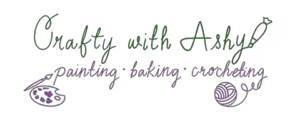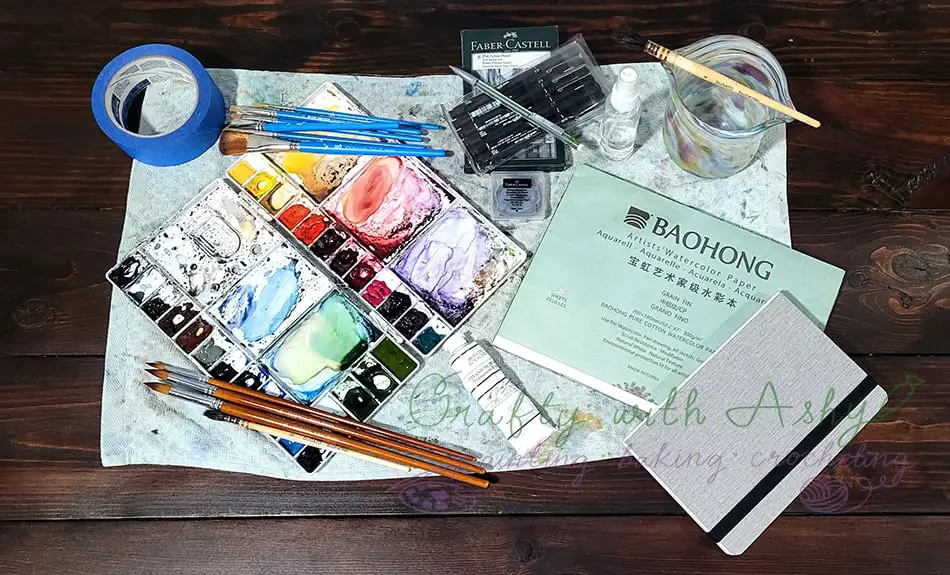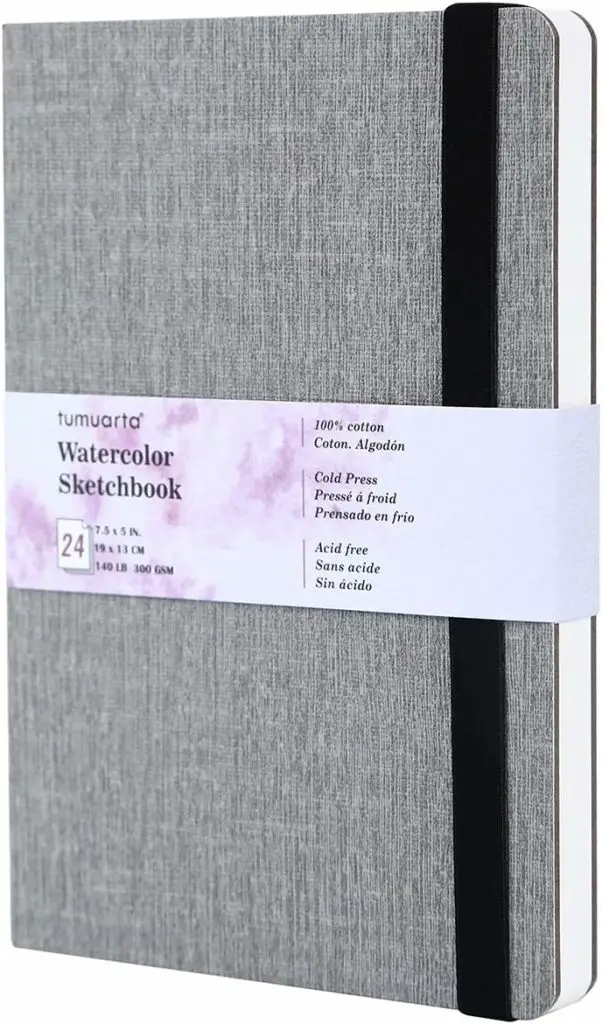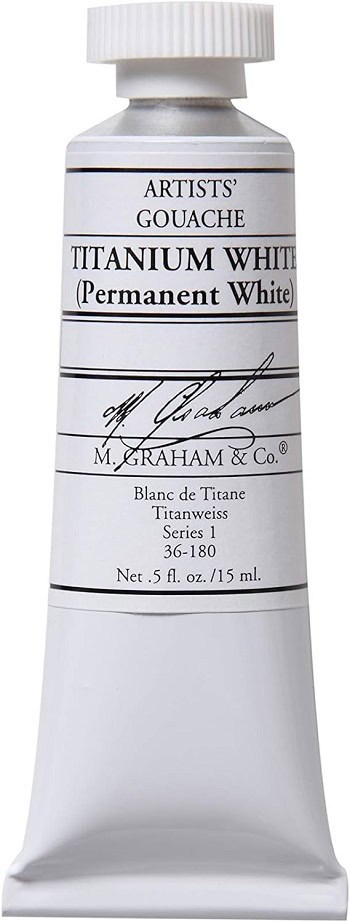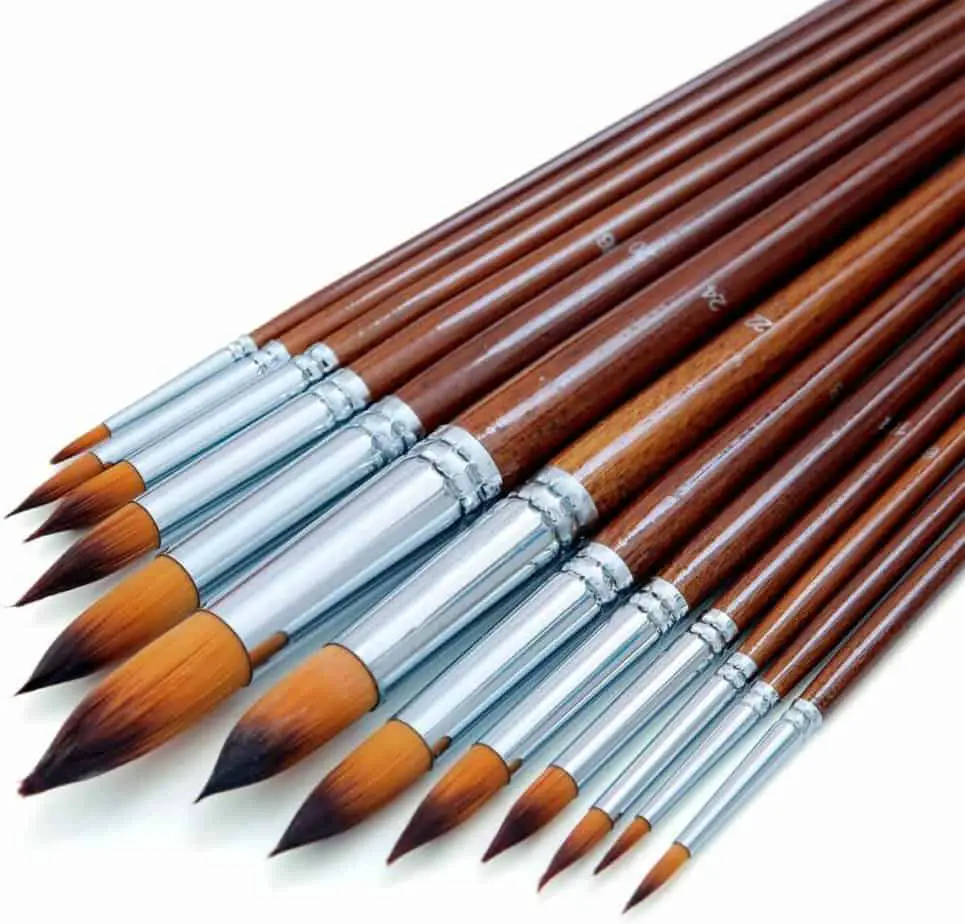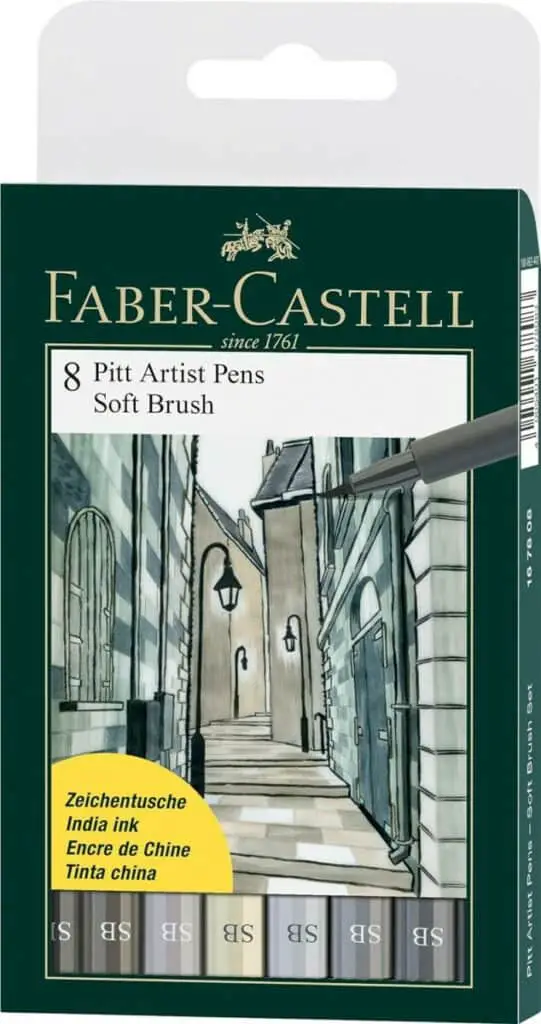When starting watercolor painting, like with any new hobby, determining what supplies to buy can be very overwhelming. This post will help guide you by giving you my 15 favorite watercolor supplies.
My 15 (Plus 1 Bonus) Best Watercolor Supplies:
- Baohong And Baohong Acadamy 100% Cotton Paper (All Textures)
- Tumuarta Sketchbook (100% Cotton)
- Winsor And Newton Professional Watercolors
- M. Graham White Gouache
- Dugato Squirrel Hair Brushes
- Dugato Round Synthetic Sable Brushes
- Princeton Select Artiste Brushes Of Various Shapes
- Water Spray Bottle
- Water Jar
- Blue Painter’s Tape
- Towels/Paper Towels
- Mechanical Pencil
- Faber-Castell Kneaded Eraser
- Faber-Castell Pitt Artist Pens (Greys)
- Unipin Fine Liners
- Library
Let’s dive into these watercolor supplies a bit further. I’ll discuss what I love about these options and why they are necessary.
Baohong and Baohong Acadamy 100% Cotton Paper (All Textures)
Watercolor paper is arguably the most important supply that you will purchase. Most people would say to upgrade your paper before you even upgrade your paint! This is why I recommend Baohong and Acadamy 100% cotton watercolor paper.
Baohong is a Chinese brand of high-quality, professional watercolor paper. Academy is the “student-grade” version of this same paper. In my experience (and that of many others), there is very little difference in the quality of these two options.
The paper behaves exactly as you would expect professional-grade, 100% cotton watercolor paper to. The sizing (how the paper is treated to allow for optimal paint absorption) is consistent and predictable.
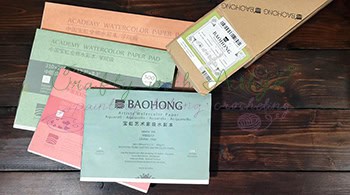
The textures are appropriate and consistent with the labels: hot press is smooth and silky, cold-pressed is moderately textured, and rough is very toothy.
I enjoy using hot-pressed for portraits. I use cold-pressed and rough for most other subjects, choosing rough when I want to paint more loosely, with less detail.
The “gold standard” of watercolor paper is Arches, but Baohong performs very similarly, and many people even prefer it over Arches. And you definitely can’t beat the price for high-quality, professional-grade, 100% cotton watercolor paper!
Tumuarta Sketchbook (100% cotton)
For painting on the go, working through compositional ideas, or practicing before painting a final piece, I use a Tumuarta sketchbook.
This sketchbook is ideal for watercolor painting because it is 100% cotton, which reacts with the water-based medium predictably and results in higher durability than other non-cotton or blended options.
Tumuarta is also cold-pressed paper, which is the most common paper texture for watercoloring. This offers a positive experience and makes it easier to transition to larger-form, high-quality watercolor papers.
Tumuarta is also cold-pressed paper, which is the most common paper texture for watercoloring. This offers a positive experience and makes it easier to transition to larger-form, high-quality watercolor papers.
The paper in this sketchbook is 300gsm. GSM indicates how thick the paper is, and high-quality watercolor papers are at least 300gsm. This allows for painting on both sides of the paper and helps the paper resist buckling or warping when water is applied. Many sketchbooks contain lighter-weight papers that buckle significantly when used for watercolor painting.
Tumuarta is made with acid-free paper, which prevents fading of your colors. This is great because sketchbooks are a fantastic way to reflect on your progress over the years (I always recommend dating the sketchbook). Acid-free paper ensures that your paintings will look fantastic for years to come.
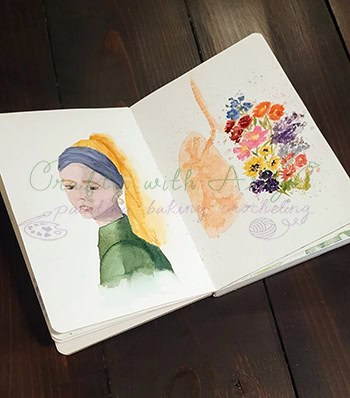
The sketchbook itself is durable and well-bound. The hard, textured cover protects the art and is visually and tactilely pleasing. It is an excellent addition to your painting supplies, especially for painting on the go! (Check out this post about traveling with watercolor if you are interested in more.)
Winsor and Newton Professional Watercolors
I chose Winsor and Newton Professional watercolor for my go-to paint. I did start with Cotman, which is their student grade line, which was perfectly acceptable. Then, when I switched to professional, I was blown away at the ease of activating the paint and picking up enough to get nice, vibrant colors on the page.
I like to use tubes and then squeeze the paint into the wells of a basic palette. My palettes are generic. I have a plastic palette for home use and an aluminum palette that came with empty pans for my travel palette. Buying tubes allows you to personalize your palette more than purchasing a pan set. It is also more affordable to buy a larger tube and refill when needed than to buy pre-made pans.

Some of my favorite colors that I will always have in my palette are Payne’s Grey, Burnt Umber, French Ultramarine, Prussian Blue, Olive Green, Permanent Sap Green, Permanent Rose, Alizarin Crimson, Yellow Ocher, Lemon Yellow Deep. I have a bunch of other colors as well, but these are my favorite and most commonly used.
For even more information about my highly recommended watercolor paint options, check out my post on the Best Watercolor Paints.
M. Graham White Gouache
Gouache is a basically opaque watercolor. Since watercolor is transparent, white watercolor isn’t the most useful; it is also controversial, but that is a different topic! White gouache is an excellent option for painting small highlight areas.
It is opaque but does dry slightly “lighter” than when wet. This, to me, is ideal because it gets some nice highlights but doesn’t overwhelm the painting. It can be layered to make it a brighter white if desired.
Gouache can be used wet straight out of the tube or reactivated with water like a watercolor pan, and I do both. I actually have a half pan of white gouache in my travel palette to use for highlights. It does take some work to activate it, but it is worth it to me!
I chose M. Graham Titanium White because it is high quality and affordable.
Dugato Squirrel Hair Brushes
Watercolor brushes are very personal, but for a brush that is affordable, holds a lot of water, and maintains an excellent point to work with, the Dugato Squirrel Hair Brushes are fantastic!
I received these as a gift from my best friend, and boy, did she do well! These brushes are made of natural squirrel hair, which is very durable and high quality. The brushes are super soft and hold a lot of water, but they still maintain a nice point, which is ideal for watercolor painting.
The “belly” of the brush acts as a reservoir for the water and paint, but the point allows significant control when needed. You can push down to the belly of the brush to make larger washes quickly. The shape makes this brush very versatile during your painting process, seamlessly transitioning from those large washes to small details.
The handle is wood, and the ferrel is a thick sheet of plastic with metal (it looks like copper) crimping. The bristles are securely in place, and I haven’t had any issues with shedding. They also just look beautiful. I like the size of the handles because they are small enough to fit in my travel palette, but they are plenty long to hold near the end for looser painting.
They also came in a lovely box, which could be reused for traveling.
Dugato Round Synthetic Brushes
Dugato makes a very affordable set of round nylon brushes. Now, there is really no need for this set of 13 different sizes, but it is super affordable, so it was great for me! This gives a range of sizes for small details to larger areas.
These brushes are good quality. I have been using them for four years and have not had any issues with the bristles shedding or losing their points. The ferrules have remained stable without any loosening.
The bristles hold plenty of water in the belly (not as much as squirrel hair). They are stiffer or snappier, so they offer great control and can be used to make a variety of brushstrokes. The paint flows from the tip nicely.
Overall, I love Dugato supplies, and I will continue to seek out Dugato in the future when I need (I mean, let’s be honest, want) more variety.
Princeton Select Artiste Brushes
I have a set of Princeton Select Artiste Brushes in various shapes. These brushes are multimedia but work well for watercolor. They have stiffer bristles than the dugato round brushes I have listed above. They are great for detailed work. Because of that stiffness, they are also perfect for lifting watercolor.
The set I purchased was affordable and came with a mop brush, an angle brush, a flat blush, a filbert brush, a round brush, and a liner (rigger) brush. This offers a wide variety of shapes to play around with. They are all on the smaller side (except the mop brush), so they are great for smaller paintings or smaller areas of your larger works.
Water Spray Bottle
I keep a small water spray bottle with my art supplies. I use it to spray down my paints for initial activation and intermittently when painting to ensure they remain juicy. I also use it to spray the paper if I want gentle moisture across the whole page or to spray and allow for natural mixing, blending, softening, and dripping during the painting process.
I got a very cheap one from a local drugstore. Nothing special is required here!
Water Jar
For home painting, I have large water jars. I have four of them on my desk, so I always have clean water. I initially use one for rinsing until it is too dirty, then I use two for rinsing and one for clean water. The final one is because it is a really far 12 steps to change out my water, so I have extra!
My jars are super special to me because I actually made them myself. I also do glass blowing, so I created these heavy and large jars with notches at the top to hold my paintbrush at a slightly downward angle to dry. They are beautiful and inspire me to be more creative!
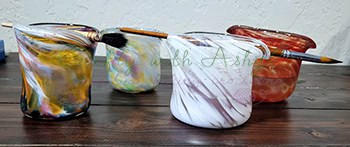
For travel, I have a jar with a lid. It was originally a store-bought caramel sauce and is a perfect small size to keep in my purse. The jar seals well and does not leak, which is perfect! I often paint in locations where I cannot dump my water when I finish painting (like church), so I seal it up and take care of it later. I tested the jar by filling it, sealing it, and then shaking it upside down to ensure it didn’t leak before deciding to use this particular jar.
Blue Painter’s Tape
I use regular blue painter’s tape from the hardware store to secure watercolor paper to a board or create clean edges on paintings. This tape creates nice, crisp lines even on rough-textured paper. It also does not rip the paper when removed.
Towels/Paper Towels
When at home, I use regular kitchen towels in my studio space.
I have one under my water jars and palette. I use the edge to dab my brush to prevent excess water from dripping on my paper. I love to use towels for this because I can just throw them in the wash when they get too dirty and reuse them. It is cheaper and better than using paper towels.
I also have a towel that I use to remove extra paint from the paper, blot out paint when needed, such as when painting clouds, and lift dried pain by applying water with a brush and then blotting away.
I do use paper towels for traveling. I reuse the same one over and over until it is too stained to use.
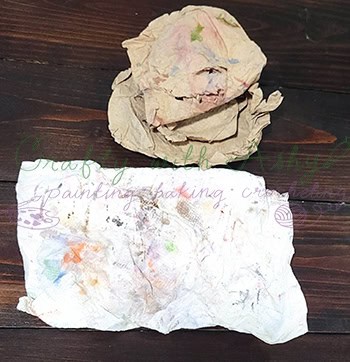
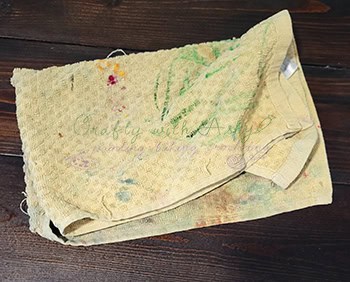
Mechanical Pencil
I use generic mechanical pencils for sketching. I never have to sharpen them. I can draw light enough to make it easy to paint over or erase if I want to before painting.
Faber-Castell Kneaded Eraser
I love my Faber-Castell kneaded eraser. I like rolling it over my paper to lift excess graphite before painting. Kneaded erasers are much more gentle on the paper than regular rubber erasers. They do not interrupt the sizing of the paper, cause pilling, or tear the paper when used.
Faber-Castell Pitt Artist Pens (Greys)
Faber-Castell Pitt Artist Pens are so fun to mix with watercolors. They are transparent and layer well over or under watercolor paints.
They are waterproof, so you have no worries when painting over them. This is a great option for sketching on the go. You can do a line-and-wash style watercolor painting. When I do this, I like to start with a line sketch and then add areas of shadow with these pens. After getting that basic sketch down, I add watercolor washes. The greys of the Pitt Artist Pens shine through and offer the depth of shadow in a controlled way. They can be layered over the watercolor to add contrast later in the painting as well.
UniPin Fine Liners
The UniPin Fine Liners are perfect for adding black line details to your watercolor paintings. They are waterproof, so they can be used under or over your watercolor painting. They have varying tip thicknesses, which offer a wide variety of line weights. This brings interest to the sketches.
They work well on watercolor paper, and mine have not had any issues with the nibs wearing out. I know they will eventually, but so far, so good (about three years of fairly consistent use).
Library
My final, bonus, “supply” is the library. I love the library anyway, but I have been digging in a bit more lately. My library is small, but there are seven watercolor-specific books!
In addition to watercolor-specific books, they have many other art books that can be used for inspiration and to learn various techniques from other mediums that may be applied to watercolor!
Another thing I have found is books of photography on different subjects or even scientific books on different subjects. Now, I don’t ever copy these directly, but they are great for inspiring creativity in terms of color, composition, subjects, etc. It is just inspiring to look at beautiful art!
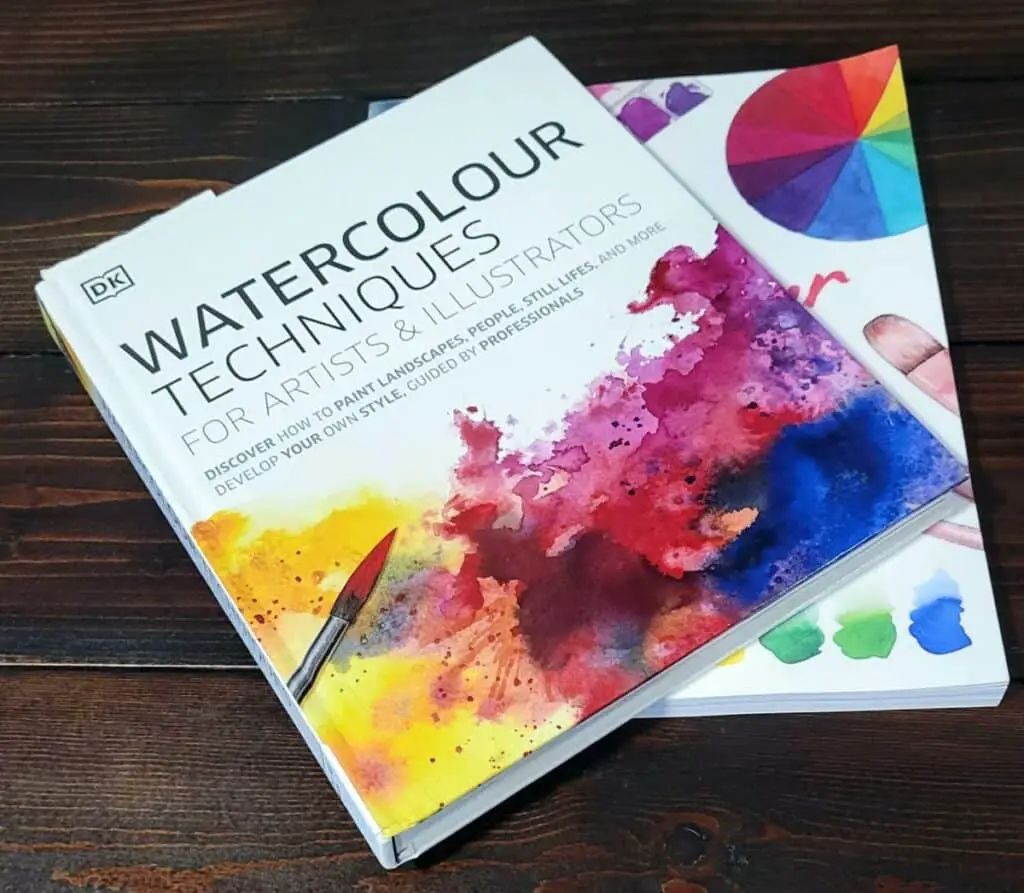
Let me know if you have any additional questions about my watercolor supplies or any other supplies! I will always try to find the answers!
Now it is time for YOU to get Crafty with Ashy!
Be sure to subscribe and follow me so you don’t miss any inspiration!
